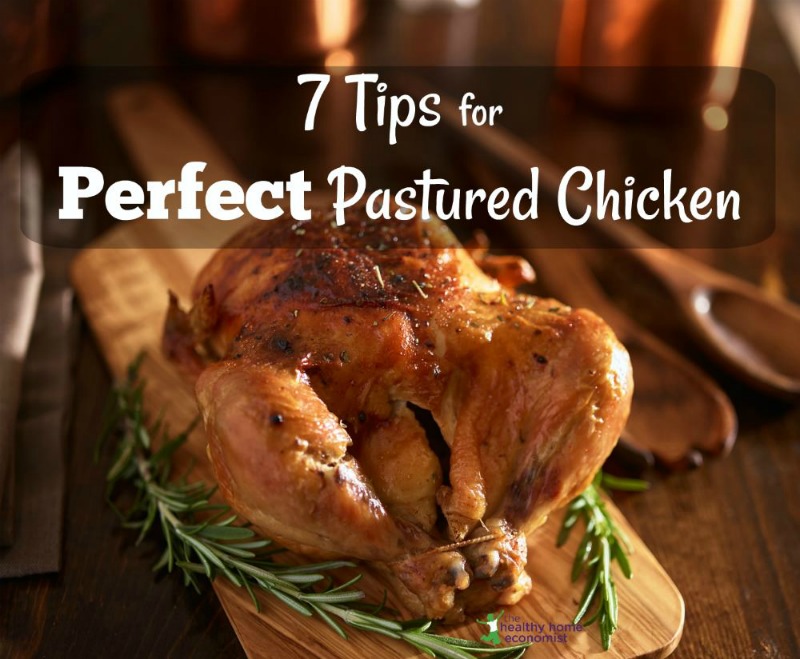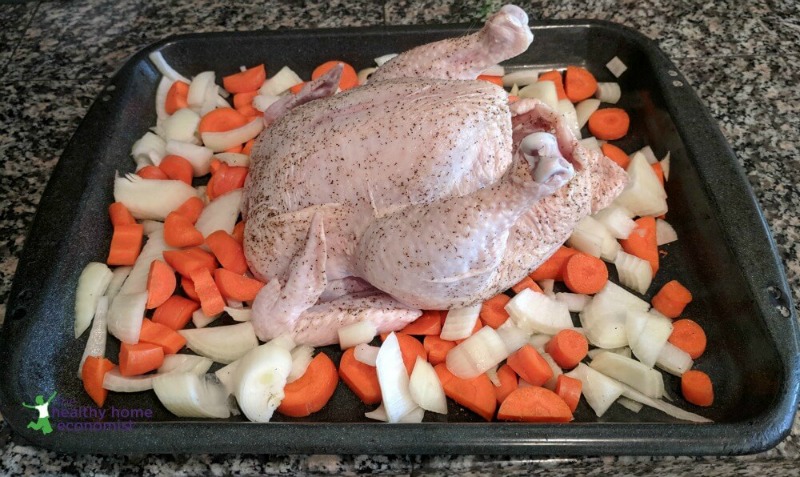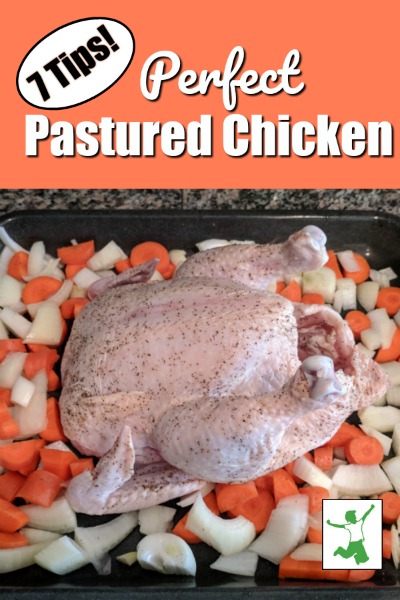Important cooking tips for roasting a chicken sourced from a pastured poultry farm to ensure a moist, juicy, and tasty result every time.
Cooking a pastured chicken carefully sourced from a local farm is an exciting experience when taking the plunge for the first time.
What some newbies may not realize, however, is that greater care must be taken when roasting pastured poultry compared to conventional birds.
If you roast pastured chicken the same way you’ve always done it, you could very well end up with tough overly dry meat that won’t seem worth the extra cost and inconvenience to procure it!
The reason why lower quality chicken seems to cook “well” no matter what you do to it is due to conventional poultry processing tricks.
Producers commonly utilize brine injection systems to pump up commercial birds with about 30% of their weight in saltwater!
Mmmm. Take off 30% from the cost of an uninjected pastured chicken and it doesn’t seem so expensive anymore, does it?
This brinewater isn’t quality filtered water with mineral-rich sea salt either.
Count on it consisting of chlorinated/fluoridated tap water, sodium, and even additives such as MSG to enhance the taste of the (usually) flavorless meat. (1)
Why do poultry producers do this?
The reason is simple. This type of processing provides a cheap safety mechanism that allows the consumer to overcook the bird, and it still turns out juicy and tender.
Try to overcook a pastured bird that doesn’t contain these synthetic enhancements, however, and your goose is literally cooked.
With that, let me share with you a few tips on how to roast a pastured bird so that it turns out perfectly every time!
Tips for Roasting Pastured Chicken
If you’ve read this far, congratulations! You probably have a pastured chicken in the refrigerator ready for roasting! Here are my best tips for making it the best tasting bird ever!
Temperature and Placement
The best temperature to roast a chicken is 400 °F/ 204 °C. Conventional chicken can cook higher at 450 °F/ 232°C, but doing this with an unenhanced pastured bird risks dryness.
Always roast in the middle of the center oven rack. Avoid roasting or baking anything else with the chicken at the same time to avoid uneven cooking.
Avoid Roasting a Cold Chicken
Placing a cold chicken straight from the refrigerator into a preheated oven risks a severe drop in temperature. This can inadvertently cause you to overcook the chicken, which will produce less than desirable results.
Instead, let the chicken sit on the kitchen counter in the roasting pan for about a half-hour. This will allow the chill to come off the meat to maximize cooking results. Worried about bacteria? Don’t be. Thirty minutes at room temperature isn’t long enough for pathogens to form.
At the completion of this short waiting period, place the pastured chicken in the preheated oven. No dramatic fluctuations in temperature will occur allowing the cooking time to be as precise as possible.
Pat the Chicken Dry Before Roasting
For those of us that know the secret that fat is our friend, roasted chicken skin is an absolute delicacy!
To enhance skin crispiness and ensure the moistest meat, pat the chicken dry inside and out with a clean white dish towel or paper towels before placing in the oven.
Basting the chicken with butter as it roasts will brown the skin and add even more flavor!
Enhance the Juices
The juices (aka “pan gravy”) at the bottom of the roasting pan contain some of the best nutrients! Don’t be a fat-phobe and throw it out!
Make chicken gravy with it or do as my husband does … pour it straight into a mug and drink it with the meal like you would homemade broth!
To enhance these juices, place the chicken on a bed of chopped onion, celery and/or carrots (1 each).
 Roast Chicken Seasoning
Roast Chicken Seasoning
Seasoning a pastured bird inside and out with coarse sea salt and pepper before roasting is a good idea for the best tasting meat. Alternatively, use your own homemade seasoning salt.
However, be sure to do this no more than a few minutes before placing in the oven. Otherwise, you risk drawing moisture out of the raw chicken meat and a dry end result.
If a chicken requires more than this, it is likely not good quality. Only low nutrient, commercially raised chicken (organic included) requires elaborate seasoning to taste good.
Truss with no Fuss
While not necessary, trussing the chicken will allow for more even cooking of the meat.
If you’ve never done this before, it’s easy. My friend Jenny at Nourished Kitchen shows you how to truss a chicken in six easy steps with pictures.
Let the Roast Chicken Rest
After roasting, let the chicken rest for 15 minutes in the pan before slicing or removing the meat. This allows for the juices to redistribute and stabilize within the meat rather than gush out into the pan if you cut it too quickly.
Wondering how to best serve that juicy pastured chicken meat? Check out these chicken recipes for some ideas!
Please share any additional tips you have for roasting pastured chickens!









No final internal temps are given. Does 160F for breast meat and 170F for dark meat also apply to a pastured chicken? Thank you.
I’ve been cooking chicken with the breasts down for years, to help keep the breast meat moist. I do like to lay it atop a bed of onions, too. I coat the back of it with coconut oil and seasonings, then baste with the juices during cooking. Typically the temperature is 350F, I’m going to try a higher temperature next time to see the difference.
Interesting cooking temperatures. I used to always roast a chicken at 160 C but in recent years have been roasting at 180 C which I think works better and gives a crispier skin. I’d be nervous to cook my chicken at 204 C!
I’d vouch for cooking the chicken on a small bed of veg; then using the juices and the now roasted veg to make the most delicious gravy…..mmmmm!
How long in the oven?
That depends on the size of your chicken so follow standard advice on that which is 20 minutes per pound unstuffed. If using a convection oven, I can say from experience that it cooks a bit more quickly so check it after 15 minutes/pound has passed and see if the juices run clear.